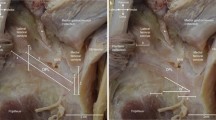Abstract
Purpose
To study the morphology and the morphometry of the oblique popliteal ligament (OPL).
Methods
Thirty cadaver knees were dissected to study the morphology and morphometry of the OPL. For the measurement of the morphology of the OPL a standard tape and the vernier callipers were used.
Result
Out of 30 specimens 14 were Y shaped, 10 were band shaped, and 6 were Z shaped observed. Total length was measured on both the limbs, on the right side it was 4.5 ± 0.4 cm and on the left side 4.5 ± 0.5 cm was recorded. Width at the medial attachment was also measured on both the limbs, on the right side it was 4.6 ± 0.5 cm and on the left side 4.7 ± 0.5 cm was recorded. And width at the lateral attachment was recorded too, on the right side it was 4 ± 0.3 cm and on the left side it was 4 ± 0.3 cm. Width at the midpoint was recorded as on the right side 3.5 ± 0.2 cm and on the left side 3.5 ± 0.2 cm.
Conclusion
The OPL is a thick ligament that arises as an extension of the semimembranosus, and it exists in various morphology which includes band, Y, Z, complex shapes.

Similar content being viewed by others
Data availability
Data are available from the corresponding author upon reasonable request.
References
Fam LPD, Fruheling VM, Pupim B, Ramos CH, de Moura MFA, Namba M, da Silva JLV, da Cunha LAM, de Oliveira Franco APG, Filho ES (2013) Oblique popliteal ligament—an anatomical study. Rev Bras Ortop 48(5):402–405. https://doi.org/10.1016/j.rboe.2012.07.010
Hedderwick M, Stringer MD, McRedmond L, Meikle GR, Woodley SJ (2017) The oblique popliteal ligament: an anatomic and MRI investigation. Surg Radiol Anat 39(9):1017–1027. https://doi.org/10.1007/s00276-017-1838-7
LaPrade RF, Morgan PM, Wentorf FA, Johansen S, Engebretsen L (2007) The anatomy of the posterior aspect of the knee. An anatomic study. J Bone Joint Surg Am 89(4):758–764. https://doi.org/10.2106/JBJS.F.00120
Morgan PM, LaPrade RF, Wentorf FA, Cook JW, Bianco A (2010) The role of the oblique popliteal ligament and other structures in preventing knee hyperextension. Am J Sports Med 38(3):550–557. https://doi.org/10.1177/0363546509348742
Osti M, Tschann P, Künzel KH, Benedetto KP (2013) Posterolateral corner of the knee: microsurgical analysis of anatomy and morphometry. Orthopedics 36(9):e1114–e1120. https://doi.org/10.3928/01477447-20130821-11
Park SE, Stamos BD, DeFrate LE, Gill TJ, Li G (2004) The effect of posterior knee capsulotomy on posterior tibial translation during posterior cruciate ligament tibial inlay reconstruction. Am J Sports Med 32(6):1514–1519. https://doi.org/10.1177/0363546504265594
Seo SS, Seo JH, Kim DH, Park BY (2015) Compression of the popliteal artery after posterior cruciate ligament reconstruction using the tibial inlay technique. Knee Surg Relat Res. 27(4):274–277. https://doi.org/10.5792/ksrr.2015.27.4.274
Wu XD, Yu JH, Zou T, Wang W, LaPrade RF, Huang W, Sun SQ (2017) Anatomical characteristics and biomechanical properties of the oblique popliteal ligament. Sci Rep 16(7):42698. https://doi.org/10.1038/srep42698
Acknowledgements
The authors sincerely thank those who donated their bodies to science so that anatomical research could be performed. Results from such research can potentially increase mankind’s overall knowledge that can then improve patient care. Therefore, these donors and their families deserve our highest gratitude. The authors also thank Jutta Knifka from the Institute of Anatomy of the University of Cologne for taking the photographs used in this study.
Funding
Open access funding enabled.
Author information
Authors and Affiliations
Contributions
EK: Done the research work. RBJ: Guide and analysis. SR: Help with the work. VM: Guide. HKL: Guide.
Corresponding author
Ethics declarations
Conflict of interest
The authors have no conflicts of interest to declare that are relevant to the content of this article.
Ethical approval
A positive ruling from the ethics committee of the medical Faculty of the university was obtained.
Additional information
Publisher's Note
Springer Nature remains neutral with regard to jurisdictional claims in published maps and institutional affiliations.
Rights and permissions
Springer Nature or its licensor (e.g. a society or other partner) holds exclusive rights to this article under a publishing agreement with the author(s) or other rightsholder(s); author self-archiving of the accepted manuscript version of this article is solely governed by the terms of such publishing agreement and applicable law.
About this article
Cite this article
Kancharla, E., Jeph, R.B., Ravichandran, S. et al. Morphological and morphometric analysis of oblique popliteal ligament in North Indian population: a cadaveric study. Surg Radiol Anat 46, 399–405 (2024). https://doi.org/10.1007/s00276-023-03288-4
Received:
Accepted:
Published:
Issue Date:
DOI: https://doi.org/10.1007/s00276-023-03288-4




